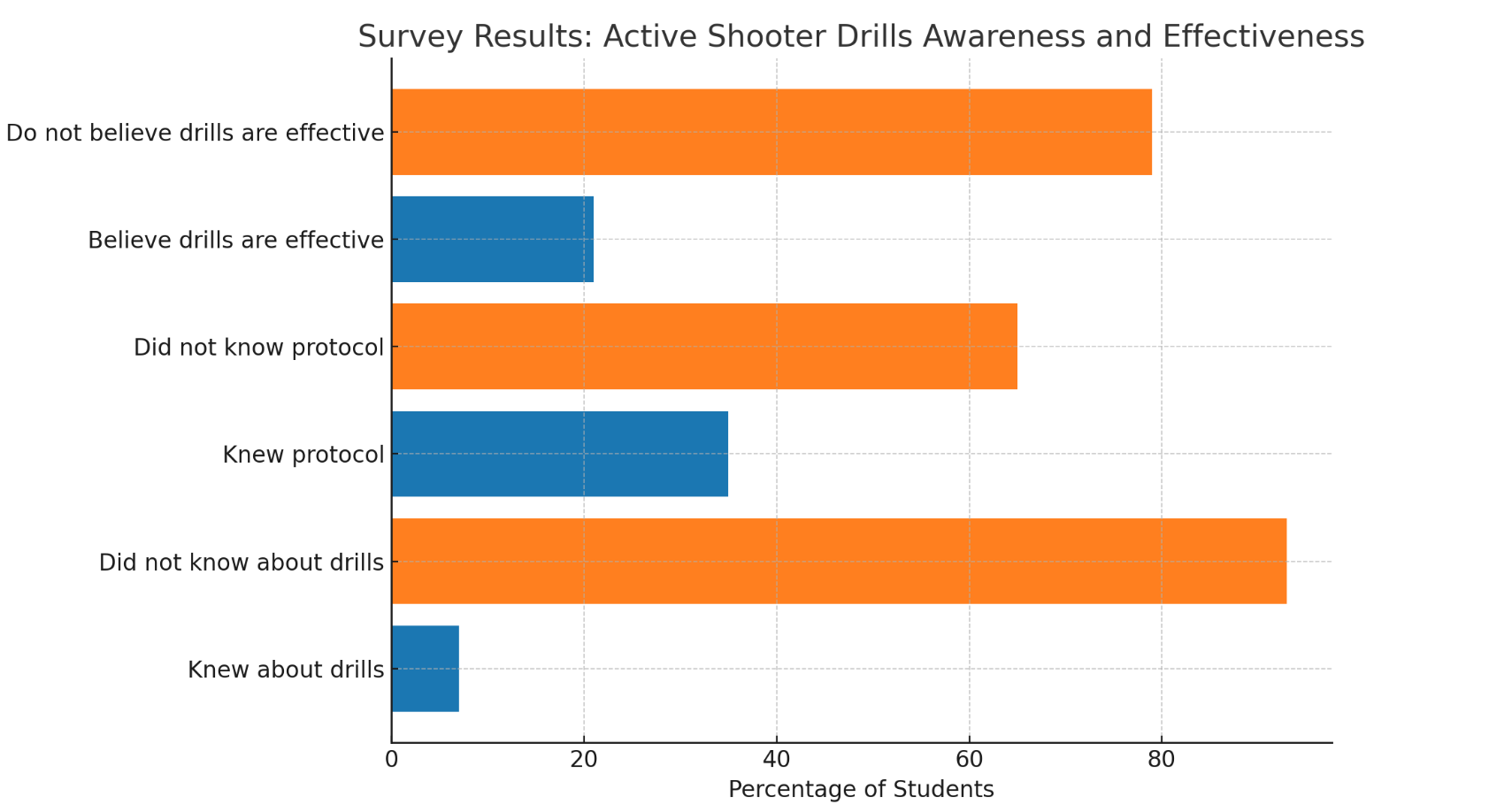College shootings - Why We Need More Active Shooter Drills on Campus—and Why Students Aren’t we Aware of Them
By: Morgan Lewis
Baltimore, MD - According to the Gun Violence Archive (GVA), there have been over 395 mass shootings in the U.S. this year alone, resulting in more than 400 deaths and 1,700 injuries. Shockingly, this includes 35 shootings on school property, as reported by Statista. Despite these numbers, many students remain unaware of active shooter drills on their campuses, an unexpected gap in safety preparedness.
Gun Violence infographic
While 95% of public schools conduct lockdown drills, there's almost no research confirming whether these drills effectively prevent school shootings or protect students and staff. Yet, universities are big environments, often spanning across cities or states, including not only academic facilities but also hospitals, athletic centers, and residential homes. The need for thorough preparedness is evident, especially given the open nature of campuses where visitors frequently come and go.
After surveying the campus of Morgan State University (MSU), I found that many students are completely unaware of any active shooter drills. If you ask, most will only recall fire drills—if they live on campus. Out of 148 students asked if they knew about active shooter drills conducted over the summer, only 11 (7%) said yes, while 137 (93%) said no. When I asked another 159 students, "If there were an active shooter on campus, would you know the proper protocol to stay safe (excluding high school training)?" 35% said yes, while 65% said no. Furthermore, when asked if they believe drills effectively prevent school shootings or protect students and staff, 79% said no, and 21% said yes.
This lack of awareness can be attributed to several factors, including poor communication and insufficient drill implementation. Universities often fail to promote these drills effectively; safety announcements may get lost in a flood of emails or missed by students who don’t engage with school social media or attend orientation events. Even when drills are promoted, students often don't participate. With busy schedules, safety training tends to fall low on the list of priorities. The constant discussion of school shootings can lead to emotional exhaustion, making students less inclined to engage in safety preparedness.
Studeny Survery chart
It's important to understand the different types of safety training that universities can implement, particularly the distinction between drills and exercises. A drill serves as an educational tool to test processes, procedures, and technology in a controlled, non-crisis setting, while an exercise is a more intense simulation, often conducted by first responders, to evaluate their training. Drills, such as fire or tornado drills, help students become familiar with emergency procedures, which can be lifesaving during an actual crisis. However, there is ongoing debate about the use of active shooter exercises that simulate real-life scenarios, as some argue these exercises may cause unnecessary psychological harm. As Guy Grace, a member of the Partner Alliance for Safer Schools (PASS) Advisory Council, aptly stated, "We don’t set our schools on fire to practice fire drills," highlighting the concern that overly realistic simulations, while intended to prepare, may do more harm than good.
To better understand why active shooter drills are not more common on campus, I spoke with the Morgan State University (MSU) police department. According to Training Coordinator Sergeant Byrd, “If we had an active shooter situation, we have software called ZeroEyes, which captures an image when a weapon is displayed and sends it to the police department within five seconds.” ZeroEyes provides a proactive, human-verified visual gun detection and situational awareness solution that integrates with existing security cameras to help prevent mass shootings and gun-related violence. When asked how students receive information about this, Sergeant Byrd explained, "Students are aware of it—we use them as actors in the drills we conduct over the summer." The main challenge, however, is logistics. MSU’s campus is large, with students constantly on the move.
Coordinating drills across such a sprawling area without disrupting academic life is difficult. Additionally, the department expressed concerns over the potential emotional toll these drills could have on students, given the rising anxiety surrounding school shootings.
Morgan State Univeristy
They stressed that although the university doesn’t frequently hold formal active shooter drills.
Ultimately, while MSU and many universities across the country have taken some steps toward improving campus safety, more needs to be done. It’s not just about having drills in place but making sure students are aware of them and prepared to act if the unthinkable happens. As students, faculty, and staff, we all play a role in ensuring our campus communities are safe, and that begins with awareness and participation in safety measures. It’s time for universities to take the next step and prioritize widespread, effective communication about active shooter preparedness.
Resources:
ALICE Training: ALICE (Alert, Lockdown, Inform, Counter, Evacuate) is one of the most recognized active shooter response training programs. It offers resources for schools, universities, and businesses on how to respond to active shooter situations.
FEMA Emergency Management Institute: FEMA provides online training and resources for active shooter preparedness, as well as broader emergency management education. They offer self-paced courses that teach safety and crisis response skills.
Everytown for Gun Safety: Everytown offers research and data on gun violence prevention, as well as advocacy and educational resources for schools and communities to address and prevent shootings.
Ready.gov - Active Shooter Resources: This government resource provides detailed guidelines on preparing for, responding to, and recovering from an active shooter event. It includes tips for both individuals and institutions like universities.
National Center for Campus Public Safety (NCCPS): NCCPS provides training, research, and resources specifically tailored to higher education institutions, helping campuses prepare for and respond to various safety threats, including active shooters.
COMM 240 Blog #4



